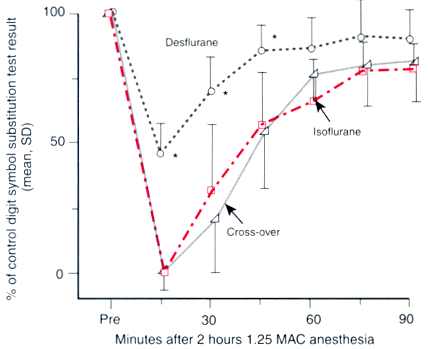 |
 |
Figure 5-22
Volunteers were anesthetized for 2 hours on three occasions:
once with 1.25 minimum alveolar concentration (MAC) of isoflurane; once with 1.25
MAC of desflurane; and once with 1.5 hours of 1.25 MAC isoflurane, followed by 0.5
hour of a combination of desflurane and isoflurane (i.e., crossover administration).
The combination provided a total of 1.25 MAC (i.e., desflurane was added as the
isoflurane was eliminated, with the addition being sufficient to sustain a total
of 1.25 MAC). All anesthetics were delivered at a 2-L/min inflow rate. At the end
of 2 hours, anesthetic administration was discontinued and a non-rebreathing system
applied. The digit symbol substitution test (DSST) was applied at 15-minute intervals,
and the results are displayed as a percentage of the control (preanesthesia) results.
Recovery of judgment and cognition as defined by the DSST was more rapid at 15,
30, and 45 minutes with desflurane given alone (asterisks
indicate significant differences from isoflurane or crossover results). (Data
from Neumann MA, Weiskopf RB, Gong DH, et al: Changing from isoflurane to desflurane
towards the end of anesthesia does not accelerate recovery in humans. Anesthesiology
88:914–921, 1998.)

 |
